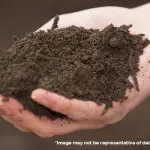Easy no-dig gardening with topsoil
Would you grow more fruit and vegetables if you thought you didn't have to dig your veg patch? The good news, then, is that not digging over your garden might be the very best thing you can do. The reason? The extraordinary ecosystem that inhabits your garden soil will dry out and die when exposed to UV rays from the sun, and by destroying the soil structure you start the vicious circle of having to dig in more organic matter to replace what was lost. Instead, by embracing no-dig gardening, you create and nurture the conditions for a fantastic yield year after year.
The topsoil bag method
By far the simplest and easiest way to get into no-dig gardening is to buy as many 20kg bags of topsoil as it will take to cover the area of your veg patch.
Slash drainage holes in one side of the bag and lay them directly on the earth. Cut away the top side of the bag completely and then water the topsoil well before planting. If you're growing tomatoes, stick to one plant per bag.
The straw bale and topsoil bed
A straw bale bed can have a particularly beneficial effect on your garden, as the bales will degrade in about a year, providing a rich compost for the next year's plants. The bales also encourage worm activity to help replenish your topsoil.
A straw bale bed is easy to create by using straw or hay bales to frame your vegetable bed. Fill with topsoil and compost, and then water well before planting. The one downside of this type of no-dig gardening is that you'll need to keep the straw bales moist, so mulch well and use a good irrigation system with soaker hose.
Frame it
If you want to create a more permanent no-dig bed, then you'll need to frame it in some way. Railway sleepers are ideal, but any timber can be used to create a bed, as long as its treated for outdoor use. You can place your beds anywhere - on bare earth, on a lawn, or even on concrete.
If you decide to create your no-dig beds on a concrete base, then add a three to four inch layer of twigs before filling your no-dig bed with organic material, including topsoil. If you're creating your beds in the winter, sow a dense green compost or add a thick layer of compost or straw as a winter mulch before planting in the spring.

